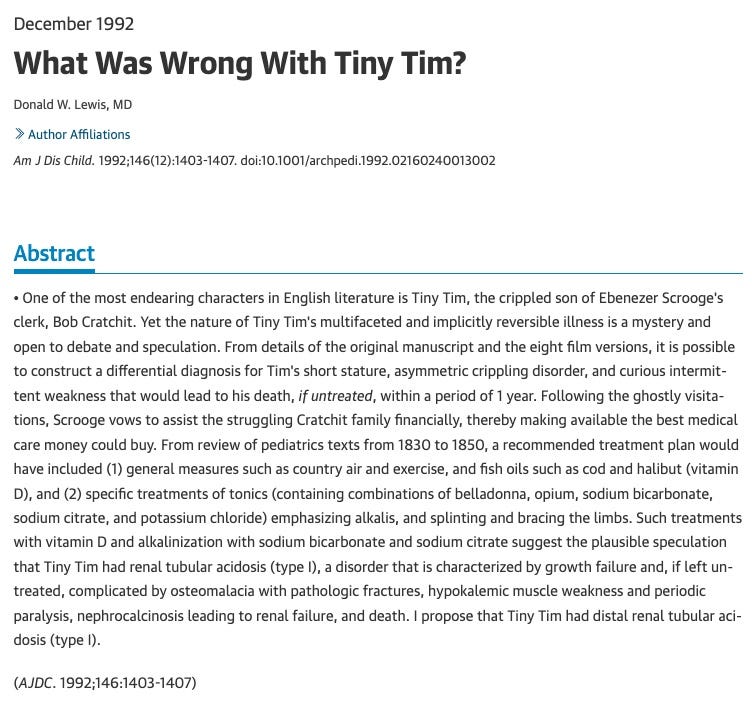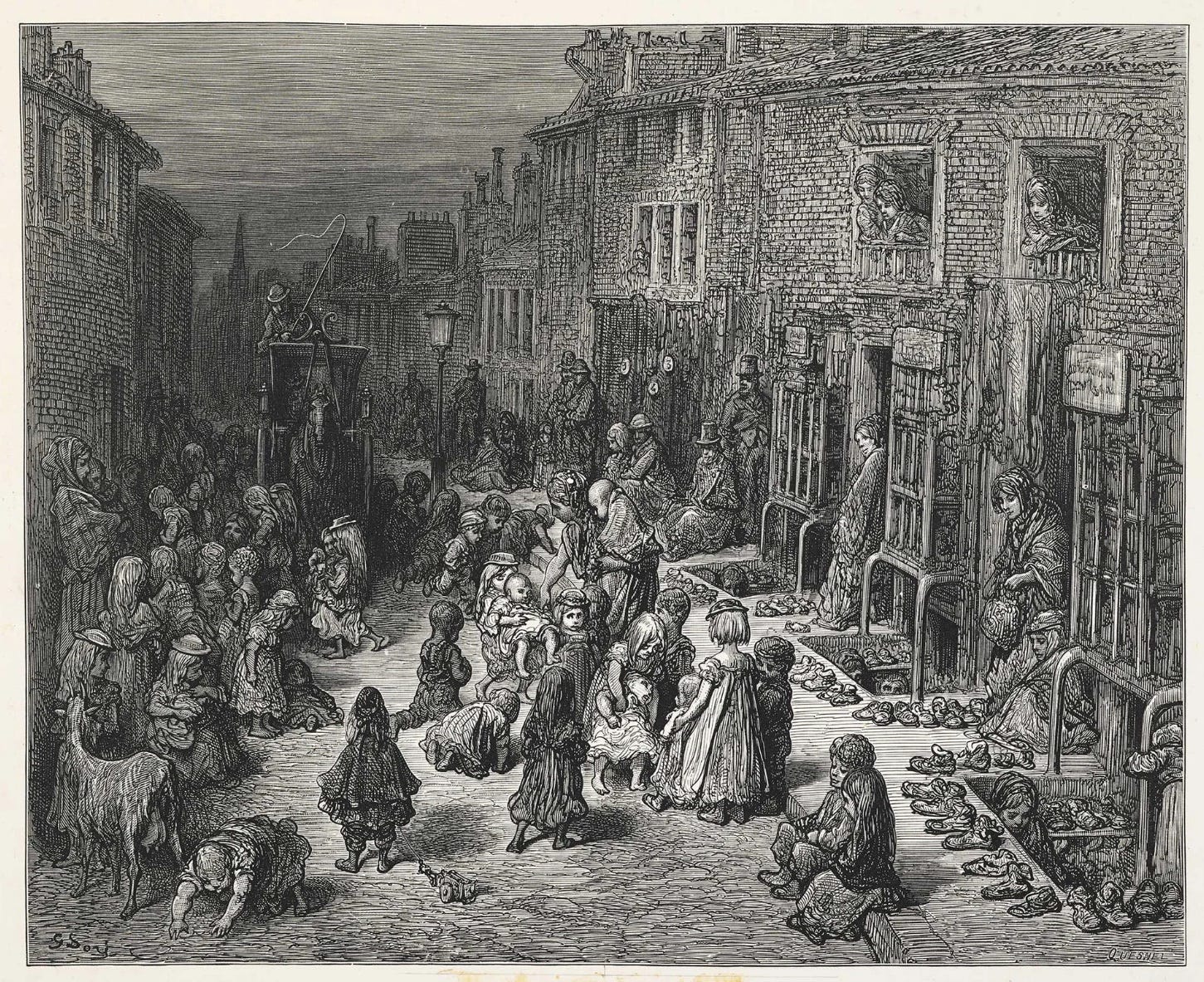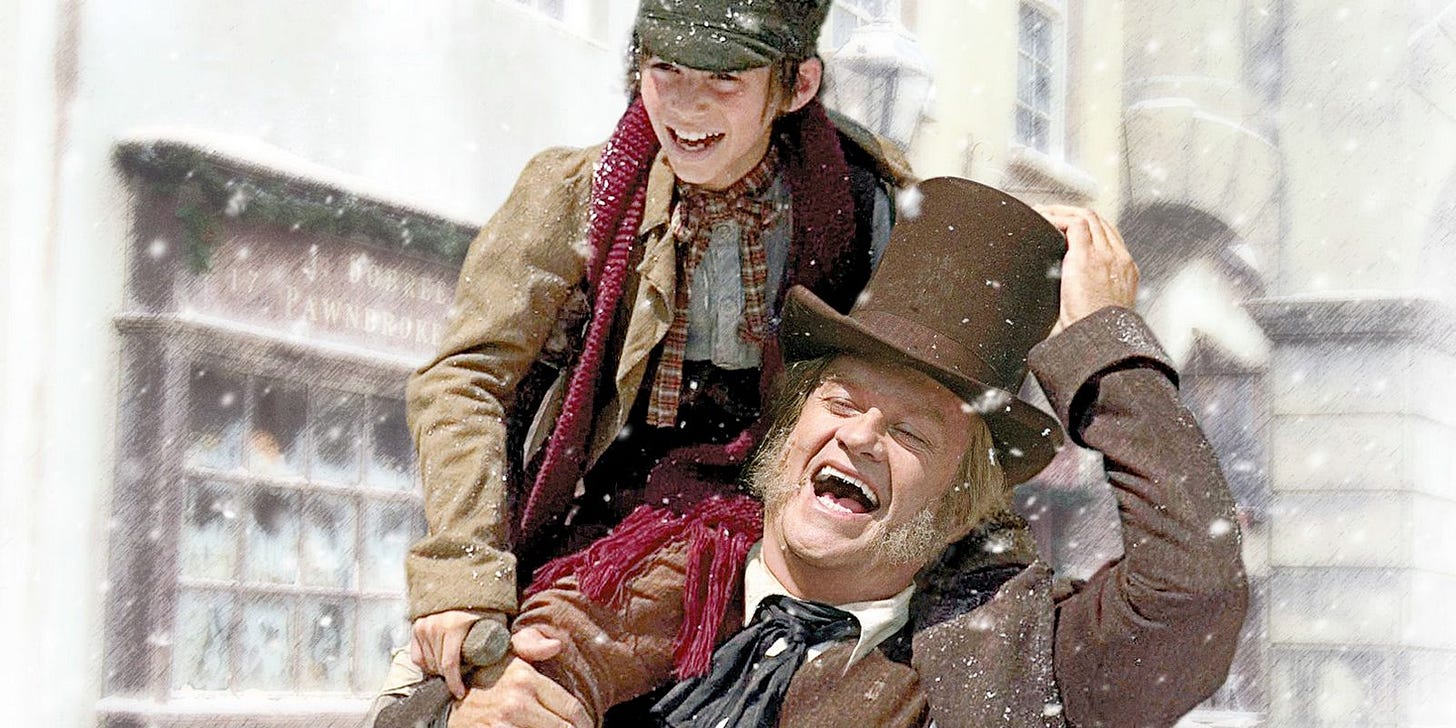A Christmas Carol has more to say about the Cratchits’ Christmas dinner than about Tiny Tim—I mean Dickens goes on for three full paragraphs about that damn pudding! We do not meet the story’s second most famous character until almost two-thirds the way through the tale. By the time we do, Scrooge’s second tour of the night is already well underway. He and the Ghost of Christmas Present are spectral flies on the wall observing the Cratchit family as they prepare for their Christmas dinner. The festivities can’t begin till Bob Cratchit and Tim return from church.
At last father and son arrive: “little Bob” Cratchit, his “thread-bare clothes darned up and brushed” ducks into the little four-room house with Tiny Tim riding on his shoulder, holding a tiny crutch, “his limbs supported by an iron frame.” During the ensuing heartwarming scene, climaxing with that pudding, we learn that in addition to whatever condition put him in braces, Tim has a “withered little hand,” and that he is weak but is perhaps on the mend—Bob’s voice quivers when he reports that the boy is “growing strong and hearty.” Things then take a decidedly dark turn.
“Spirit,” said Scrooge, with an interest he had never felt before, “tell me if Tiny Tim will live.”
“I see a vacant seat,” replied the Ghost, “in the poor chimney-corner, and a crutch without an owner, carefully preserved. If these shadows remain unaltered by the Future, the child will die.”
The ghost’s reply sets the terms for A Christmas Carol’s dramatic resolution—establishing that what is at stake in Scrooge’s redemption extends far beyond the miser’s reputation or sense of self. No longer merely a bleak tour of the missed opportunities and character flaws that brought Ebeneezer from fearful young man to heartless old miser, Tim’s fate in this timeline instills in Scrooge the notion of an alternative timeline—at timeline he alone can manifest—if he will take up the charge. So, the plot of our most favored secular Christmas story hinges on whether its most sympathetic character’s unnamed ailment can be cured. Tiny Tim is Schrodinger’s waif.
The question of Tiny’s condition became a live issue for me as I explored the rise of rickets in Victorian Britain. I know that the Medical Historian Handbook discourages using our skills to reopen truly cold cases. But those cases are so tantalizing! Did Washington’s doctors kill him with their bleedings and enemas? Was Franklin’s famous gout the result of too much chess and sedentary pursuits, or the “find out” phase of a lifetime of exposure to lead in print shops or the barrels of lead-tainted wine he may have drunk over his long life? Dickens himself left a treasure trove of self-reported symptoms and a dramatic death that have inspired much retrospective diagnosis.
We are especially discouraged from applying modern conceptions of diseases and medicine to yesteryear’s understandings. Purists cringe when someone says Chopin died from tuberculosis when everyone then knew he died of consumption. I mean he played his last concert over thirty years before Koch identified the tubercle bacillus and died only a few years before the word “tuberculosis” appeared in medical books.
Those same purists reserve a special circle of judgment for those who would conduct retroactive diagnosis on fictional characters like Tiny Tim. Was Hamlet depressed, bipolar, schizophrenic, or what? Why was Pink comfortably numb? Just what was eating Gilbert Grape? Well, this is a blog, not an article in a medical history journal, so I say Damn the torpedoes! Ignore the scolds! Let’s explore just why Tiny Tim Cratchit needed those braces! And what condition could bring certain death without Scrooge’s assistance, but be reversed by interventions that were available in 1843?
For decades historically minded physicians have been taking to the pages of medical journals to diagnose Tiny Tim. Their findings include (alphabetically) cerebral palsy, myelodysplasia, polio, renal tubular acidosis, rickets and tuberculosis. Although there’s an element of whimsy in most of these treatises most also represent the authors’ earnest effort at playing House as historian. The published responses by critics who rise to correct their colleagues’ misguided attempts at retrospective diagnosis are a lot less whimsical.

I naturally find myself on Team Rickets. The sunless streets of Camden Town and the Cratchits’ dire poverty could easily bring on rickets severe enough to produce Tim’s skeletal defects. But could rickets lead to the death foretold by the Spirit of Christmas present? Rickets today is seldom fatal, but hundreds of children died directly from it each year in Dickens’ time. Rickets can distort the bones of the ribs as readily as it bends the long bones of the leg, and as eminent pediatrician John Howland explained years later, the rickety chest “sinks in,” restricting its ability to expand, and as a result, “the frequent infections of early childhood, especially those of the lungs, become “more than the child can bear.”
Just as important as its potential fatality, and crucial for the ghost story’s redemption arc, rickets responds splendidly to improvements in diet and environment. A course of cod liver oil, an elixir widely used for rickets, scrofula, and consumption is a superb source of vitamin D so it would be a great place to start. Add some time spent in one of Britain’s sanitaria, and it is not at all fantastical that Tiny Tim could be restored to health.
The question of why the other Cratchit children are not similarly debilitated is at least partly addressed by factors related to birth order. Without a good source of calcium in her diet, Mrs. Cratchit’s calcium stores might have been depleted by nursing Tim’s older siblings before Tim arrived; and since the Cratchit family grew faster than Bob’s income, their nutritional status may have diminished accordingly. Of course, there’s no reason the other children may have had milder cases of rickets; also, since we’re able to write the plot, Tim might have contracted any number of infectious diseases that weakened his system further at a crucial point in his development, leaving him sickly and stamped with the after-effects of rickets.
Even as I make this sheepish attempt at diagnosis, I can hear the ghost of Dickens approach to reproach me and the army of dabbling docs that came before. “You want to know what Tiny Tim’s disease was? Before I answer, there's something I wanted to say. Having read all your opinions over the years, and some of you have spent... y'know... hundreds of hours to publish them, I'd just like to say... GET A LIFE, will you people? I mean, for crying out loud, it's just a ghost story. You've turned an enjoyable little job, that I did as a lark, into a COLOSSAL WASTE OF TIME!
OK. It’s not important to know, and in any case is impossible to know, what specifically caused Tiny Tim’s afflictions. Tiny Tim had a bigger role to play than mere patient to be diagnosed.
Whether or not Tiny Tim had rickets, thousands of children in the London of Scrooge’s time did. London physician John Snow knew something about this. A few years after the 1854 cholera epidemic that made him famous, he wrote that in his extensive “practice amongst the poor of London,” he was “struck with the great number of cases of rickets.” “It seemed almost the rule,” he noted, “and might be observed in the streets and the parks” as well as among the patients he saw at Westminster Hospital. It’s likely that upwards of two-thirds of children in most European cities exhibited clinical symptoms of rickets.
It’s likely that upwards of two-thirds of children in most European cities exhibited clinical symptoms of rickets.
Dickens could not have been unaware of this. The word “rickets” itself is missing from Dickens’s works, but in both his fiction and nonfiction he describes its consequences: He introduces Jack Dawkins, Oliver Twist’s “Artful Dodger,” as “short of his age: with rather bow-legs, and little, sharp, ugly eyes.” Dickens’ alter ego, the Uncommercial Traveler, described a few bowlegged individuals. At least twice he describes characters as “rickety,” though not in a clinical sense; for instance, a cockney “resurrection man” in A Tale of Two Cities says of himself, “I am as rickety as a hackney-coach.” The use of “rickety” to describe unsound furniture or buildings (or workers) was new in the nineteenth century, but by Dickens’ time it appeared frequently in print; rickety tables and chairs dot his novels and nonfiction. We also know that he knew about cod liver oil’s uses—in fact he took it himself.

One fact about rickets seemed obvious to doctors and social critics. Its cause was tied to the darkness and poverty of modern cities—the darkness and poverty that Dickens described so well, as in this introduction to the Cratchit’s neighborhood:
“The sky was gloomy, and the shortest streets were choked up with a dingy mist, half thawed, half frozen, whose heavier particles descended in a shower of sooty atoms, as if all the chimneys in Great Britain had, by one consent, caught fire, and were blazing away to their dear hearts’ content. There was nothing very cheerful in the climate or the town, and yet was there an air of cheerfulness abroad that the clearest summer air and brightest summer sun might have endeavoured to diffuse in vain.”
If you’re still disappointed that we can’t say for certain that Tiny Tim had rickets, I can offer as consolation “Little Bob.” In 1867 social journalist James Greenwood penned perhaps the most compelling description of an unambiguously rickety child in all of Victorian “social problem” literature. Greenwood’s “Little Bob in Hospital,” published in London’s Evening Star has no ghosts or misers, but like A Christmas Carol, tells a rescue story, with Greenwood himself the hero.
Walking down a garbage-filled cobblestone street lined with “tall, gaunt, smoke-dried edifices,” he comes upon a swarm of children engaged in “vigorous recreation afforded by shuttlecock and battledore.” Greenwood’s way is blocked by a “three-year-old philosopher” with “shockingly thin white legs crossed tailor-wise on the chill black pavement” sitting mute and stock still, “appealing out of his big heavy eyes to somebody to help him.”
Greenwood’s description of the boy matches the classic clinical presentation of severe rickets: “He had a monstrously great head, poor child, and a pot-belly, the two seemingly comprising a burden to which his puny strength was quite unequal.” Greenwood asks one of the children if the boy can walk. “How can he when he’s got the rickets?” came the reply. “Can’t you step over him, stoopid?” Greenwood lifts the boy off the cobblestones, sets him on a doorsill, and begins his inquiry. His name is Bob; the sassy girl it turns out, is paid three pence a day to watch him. Bob has seen no doctors. “What’s the use, when it’s rickets?” says the young girl. “He’ll have to grow out of them. That’s wot his young sister died of.”
Moved to speedy action, Greenwood arranges a bed for Little Bob at the Hospital for Sick Children in Great Ormond Street. Weeks later when Greenwood visits the hospital, he finds that the boy, formerly of “towzled-hair and the hollow-eyes so eloquent of pain o’nights,” has been transformed into a “clean, bright, mischievous little urchin.” Greenwood does not linger in the hospital long enough to find out what the doctor (referred to as “the magician”) did to transform Little Bob. Greenwood did not address the medical side of rickets with any specificity. Like Dickens and the other Victorian social critics, he seemed less interested in the clinical causes of specific diseases than in decrying the conditions that produced the general deadliness of the nineteenth-century city.
The stories of Tiny Tim and Little Bob are tied by far more than being about sickly waifs with memorable names. The Great Ormond Street Hospital where Greenwood takes Little Bob to be cured, was established in 1852, the first children’s hospital in Britain. Charles Dickens had been an important supporter of its creation. He was friends with its founder, Dr. Charles West, and spoke frequently at fundraisers and energetically promoted, in his fiction and journalism, the importance of such institutions. It’s tantalizing to imagine that Tim’s survival was the result of audience responses to Dickens’ readings. The first draft of Christmas Carol does not confirm that Tim lives, but when he first gave a public reading with the revised passage the audience gasped in delight at the newly-inserted reprieve. Greenwood, too, was a fervent supporter of the institution. “Little Bob in Hospital” proved a popular advertisement for the Hospital for Sick Children. He republished it twice, the second reprint renamed “Tiny Tim in Hospital.”
Little Bob’s rickets diagnosis couldn’t be more certain, and we can abandon as irrelevant the question of whether Tiny Tim had rickets, because for both writers what mattered is the same thing that mattered to that psychiatrist who reassured a certain member of the Jets that his problems could be traced to society’s ills. Riff was relieved to know: “Hey! I got a social disease!” Like Riff, Tiny Tim had, if not a social disease, then certainly a socially constructed disease. Whatever put Tim in those braces was remediable by environmental change, good care, and nutrition. Tiny Tim was a pitiable child but in his spirit and his flesh a good little English Boy, and so the perfect patient for demonstrating “The Social Problem” in Britain and its cure: if three spirits could do an “Inception” on Ebeneezer Scrooge, convincing him in his sleep to pay it forward and make Tiny Tim whole again, reformers could work a similar conversion on society at large; a chastened Britain could end rickets and other diseases of filth and poverty.
Tim’s more immediate function in A Christmas Carol, of course, was to prove, by surviving, that Scrooge’s transformation is sincere and permanent: “Scrooge was better than his word. He did it all, and infinitely more; and to Tiny Tim, who did NOT die, he was a second father.”

For more history of rickets content, get a copy of Starved for Light: The Long Shadow of Rickets and Vitamin D Deficiency. It’s the perfect holiday gift for those history-of-medicine-hungry folks on your list.






